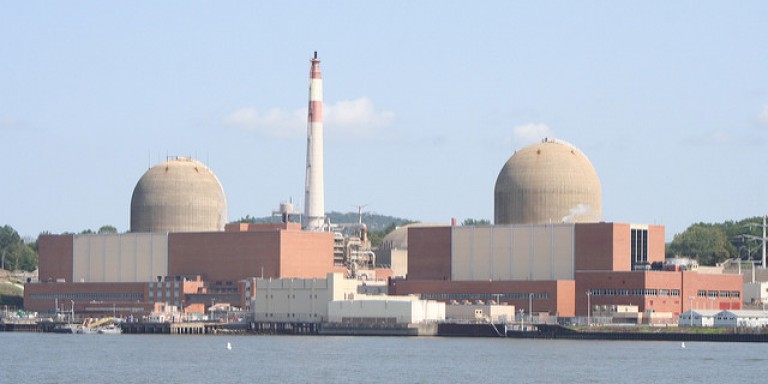Indian Point Nuclear Plant Leak – Tritium – New York
Posted February 11, 2016 by David Schumann | A Nuclear World

A gross leak of tritium has been detected coming from the Indian Point Nuclear Power Plant in New York. This post will serve to update status on this ongoing leak.
Tritium is radioactive hydrogen, or H3. It has leaked from 48 of 65 United States nuclear reactors and is a persistent health hazard around nuclear facilities (source). It will bind anywhere that hydrogen does, including water and tissue of the body. As such it can go anywhere in the body, even into the DNA, to irradiate local cells with beta radiation. With a half-life of 12.3 years, tritium is a persistent pollutant that nuclear facilities are allowed to discharge into the environment at will, because it is not practical to filter it out.
Nuclear facilities are allowed to leak as much radioactive contamination as they deem ‘as low as reasonably achievable,’ and since tritium is incorporated into water (tritiated water) and easily escapes as radioactive hydrogen gas, it is released all the time in large quantities from nuclear facilities. The nature of this leak is very different than ‘more typical’ releases and the news sources below point to serious issues at the nuclear power plant that sits 25 miles from New York City.
Articles to read:
- Reports a serious leak of tritium into the ground and groundwater below the Indian Point Nuclear power station.
- The plant has been plagued with issues this last year and the leak appears to be increasing with levels of tritium rising.
‘The news just keeps getting worse’, said Paul Gallay, president of the watchdog group Riverkeeper. ‘Our concerns go beyond the spike in tritium levels. This is about a disturbing recurrence of serious malfunctions — seven over the last eight months.’
- Governor Cuomo expressing concern:
‘Last week the company reported alarming levels of radioactivity at three monitoring wells, with one well’s radioactivity increasing nearly 65,000%,’ Cuomo said. ‘The trends of unexpected outages and environmental incidents like these are extremely disconcerting.’
- Tritium levels beyond EPA limits in groundwater beneath the plant due to a leak at the plant.
New testing has shown that the amount of tritium in the groundwater below the Indian Point power plant in Buchanan, New York, is about 740 times the amount allowed in drinking water, though officials said there was no public health risk from the leak.
Entergy Corp., which operates the plant at the edge of the Hudson River, said Wednesday that the latest samples from monitoring wells found tritium at a level of 14.8 million picocuries per liter. The U.S. Environmental Protection Agency has set a limit of no more than 20,000 picocuries per liter in drinking water.
- Location of the leak uncertain, but likely related to old, corroded, underground pipes.
‘There a leak somewhere, and I don’t think they know where it is,’ said Arnold Gundersen, a nuclear engineer and former industry executive who now runs a nonprofit group dedicated to nuclear safety.
An Associated Press investigation, published in 2011, found that three quarters of commercial nuclear power plants in the U.S. had reported tritium leaks.
Those spills were often linked to corroded, underground pipes. Experts have questioned whether the plants are capable of catching leaks and spills promptly in the maze of buried pipes that the plants use to move coolant.
- Reports the facility has been leaking for more than a decade and from both reactor and spent-fuel pool cooling waters.
For more than a decade, it has been impossible for operators of the Indian Point nuclear power plant to stop highly radioactive reactor and spent fuel pool coolant from leaking into the groundwater and migrating to the Hudson River.
- Reports that it is not only tritium that is leaking, but other very hazardous man-made isotopes such as strontium-90 and cesium-137, both easily incorporated into the body because of their similarity to potassium and calcium.
‘Tritium,’ explained David Lochbaum, nuclear safety expert at the Union of Concerned Scientists, ‘is just the first item reported. It tends to be the leading edge of any spill since it is the lightest and most mobile of the radioactive contaminants. The other isotopes slow down as they go through the soil. That other stuff is on its way, however. Tritium just wins the race.’
While Entergy focuses attention on tritium, a radioactive form of water and the predominant contaminant leaking from the plant’s cooling system, the actual leak contains a basket of radioactive elements, including Strontium-90, Cesium-137, Cobalt-60, and Nickel-63 according to an assessment by the New York Department of State…
NIRS.ORG fact sheet on Tritium
Comments ( 0 )